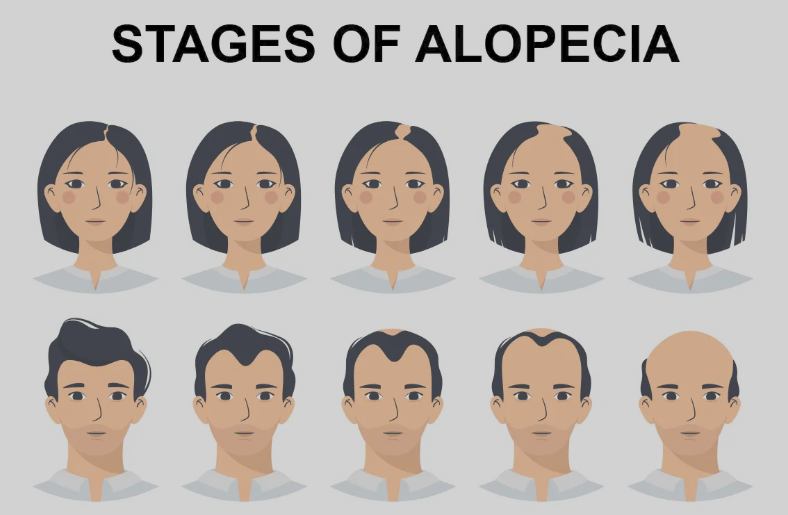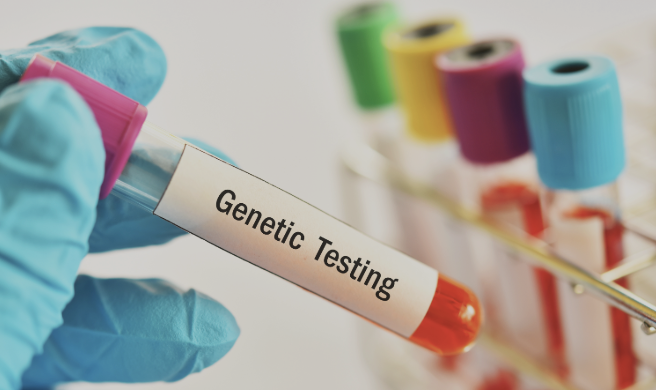Hair loss is a topic I have explored for many years and I have always found it interesting how our genetic makeup drives various conditions, and hair loss is one of them. In this article I share what I have learned about the genetics behind hair loss, with a focus on androgenetic alopecia, which is also known as male or female pattern baldness.

I am intrigued by androgenetic alopecia because it is the most common type of hair loss. This condition is largely driven by hereditary factors. Studies have shown that it is not linked to a single gene but is polygenic, meaning several genes contribute to its development. One of the genes that has received attention in research is the androgen receptor gene or AR gene. Variations in the AR gene appear to increase the sensitivity of hair follicles to dihydrotestosterone, commonly known as DHT, which can trigger miniaturization of hair follicles.
Understanding Androgenetic Alopecia: Causes, Genetics & Treatment Options
Androgenetic alopecia (AGA), commonly known as male or female pattern baldness, is the most common cause of hair loss worldwide. Affecting up to 80% of men and nearly 50% of women as they age, understanding its roots can help guide better management and treatment decisions.

What Is Androgenetic Alopecia?
- AGA is a progressive hair loss condition primarily caused by genetic and hormonal factors.
- It results in gradual thinning and, in men, often leads to a receding hairline or bald patches.
- In women, it typically appears as diffuse thinning across the crown without total baldness.
📚 Study: Ellis et al. (2001)
The Genetic Link: Why AGA Runs in Families
- AGA is polygenic, meaning multiple genes contribute—not just one.
- A key gene involved is the androgen receptor (AR) gene, which affects how hair follicles respond to dihydrotestosterone (DHT).
- The AR gene is located on the X chromosome, inherited from the mother—but genes from both parents influence risk.
📚 Study: Hillmer et al (2005)
What Triggers Hair Loss in AGA?
- DHT sensitivity causes hair follicles to shrink, shortening the growth (anagen) phase and thinning hair over time.
- Hormonal changes, aging, and stress can accelerate hair loss.
- Conditions like telogen effluvium (temporary shedding) or autoimmune disorders (e.g., alopecia areata) may also contribute.
Treatment Options for Androgenetic Alopecia
1. Minoxidil
- A topical solution that boosts blood flow to hair follicles and extends the growth phase.
- Available over-the-counter in 2% and 5% concentrations.
2. Finasteride
- An oral medication that blocks the conversion of testosterone into DHT.
- Slows hair loss and may promote regrowth over time.
3. Dutasteride
- Similar to finasteride but more potent.
- Increases hair count significantly but may carry a higher risk of side effects.
📚 Study: Gupta et al (2022)
Lifestyle Tips to Support Hair Health
- Nutrition: A diet rich in iron, zinc, vitamin D, and protein supports hair structure.
- Stress management: Activities like exercise, meditation, or outdoor time improve circulation and reduce shedding.
- Gentle hair care: Avoid harsh treatments and tight hairstyles that strain follicles.
Is Genetic Testing Useful?

- Genetic tests can now assess your predisposition to AGA and predict your likely response to treatments like finasteride.
- While not diagnostic, they can help personalize your approach to hair care.
📚 Study: Zhuo et al (2012)
Advanced Insights into Hair Loss Treatment & Prevention
As science digs deeper into the root causes of hair loss, exciting advancements are starting to emerge — especially for those looking beyond traditional treatments.
🔬 Gene Expression & Hair Follicles
Researchers are exploring how specific genes influence hair follicle activity. Understanding these mechanisms is key to developing more targeted, effective treatments for androgenetic alopecia and beyond.
🧬 Personalized Medicine: The Future of Hair Care
One of the most promising developments is personalized medicine. By analyzing your genetic profile, doctors may soon predict which treatments—like finasteride or minoxidil—will work best for you. This tailored approach could help minimize side effects and maximize results.
🧪 Clinical Trials & What’s Ahead
While many of these breakthroughs are still in early clinical or animal trials, initial findings are encouraging. New therapies focusing on genetic pathways could eventually change the way we treat hereditary hair loss.
💡 What You Can Do Now
- Stay informed about ongoing research and developments.
- Consult a hair loss specialist for personalized advice.
- Explore your options, especially if conventional treatments haven’t delivered results.
The future of hair restoration is moving toward precision and personalization. The more we learn about our genetics, the closer we get to truly effective, long-term solutions.
Frequently Asked Questions
This section addresses common questions that come up when discussing the genetics of hair loss.
Question: Is hair loss inherited from the mother or father?
Answer: While early theories emphasized the role of the mother’s side, recent research shows that hair loss can be inherited from both parents. The influence of the AR gene, found on the X chromosome, makes hair loss more noticeable from the maternal side in men. However, genes from the father also contribute, making both parental histories important in evaluating risk.
Question: What is the best predictor of baldness?
Answer: In my experience, the combined influence of multiple genes offers the best predictor of baldness. It is not a single gene that determines the outcome. Instead, the aggregate effect of many genetic factors that interact means that family history on both sides should be considered to understand risk accurately.
Question: Which parent passes down the hair gene?
Answer: The AR gene is on the X chromosome, which means that men typically inherit this gene from their mother. Nonetheless, other hair loss-related genes come from both parents, so the risk is not exclusive to just one side of the family.
Question: How can I stop hair loss due to genetics?
Answer: While I have learned that completely halting genetic hair loss is challenging, several strategies can help slow its progression. These include medications like finasteride and minoxidil, lifestyle changes such as managing stress and ensuring proper nutrition, and in some cases, exploring surgical options like hair transplants. Consulting a healthcare professional can offer guidance about the best approach for your personal situation.
Final Thoughts
It is important for anyone facing genetic hair loss to recognize that a well-rounded approach tends to give the best results. I advise those concerned to consider both medical treatments and lifestyle adjustments. Early intervention can sometimes slow the onset or progression of hair loss more effectively.
Managing androgenetic alopecia involves understanding both your genetic makeup and the biological factors at play. While there’s no one-size-fits-all solution, combining early treatment with lifestyle changes can help slow progression and preserve hair health. Stay proactive, consult professionals, and explore evolving treatment options—including promising advances in personalized, genetics-based therapies.
References:
- Ellis, J A., Stebbing, M., & Harrap, S B. (2001). Polymorphism of the androgen receptor gene is associated with male pattern baldness. J Invest Dermatol , 116(3): 452-5
- Hillmer, A M., Hanneken S., Ritzmann S et al. (2005). Genetic variation in the human androgen receptor gene is the major determinant of common early-onset androgenetic alopecia Am J Hum Genet Jul;77(1):140-8
- Gupta, A K., Venkataraman, M., Tulkd M et al. (2022) Relative Efficacy of Minoxidil and the 5-α Reductase Inhibitors in Androgenetic Alopecia Treatment of Male Patients JAMA Dermatol. 158(3):266-274
- Zhuo F L., Xu W., Wang L., Wu Y., Zhao J Y. (2012) Androgen receptor gene polymorphisms and risk for androgenetic alopecia: a meta-analysis Clin Exp Dermatol Mar;37(2):104-11

Hi Rebecca,
This post on the genetics behind hair loss is incredibly informative and well-written! I really appreciate how you broke down complex topics like androgenetic alopecia and hormonal factors in such a clear, approachable way. It’s so helpful to understand the science behind why hair loss happens. Thank you for sharing such valuable insights! I was wondering: for someone with a family history of hair loss, what’s one proactive step they can take early on to potentially slow or manage it? Thanks again for this great article!
Sincerely,
Steve
Hi Steve,
Thank you for your comments. I’m really pleased the post was informative and helpful to you.
One proactive step is starting early scalp care with proven treatments like minoxidil or low-level laser therapy, especially if you notice early thinning. Maintaining a healthy lifestyle—balanced diet, stress management, and avoiding harsh hair practices—also supports follicle health. Consulting a dermatologist for a personalized plan, possibly including genetic testing, can help tailor prevention strategies. Early intervention often slows progression and preserves more hair over time, particularly for those with a family history of hair loss.